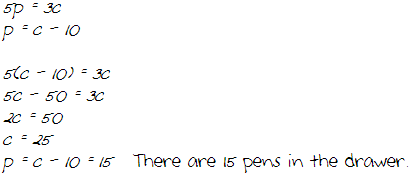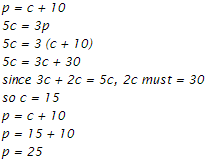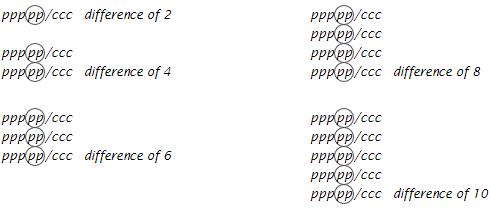Test Information Guide
Field 203: General Curriculum
Mathematics Subtest
Sample Open-Response Item
The following materials contain:
- Sample test directions for the open-response item
- A sample open-response item
- An example of a strong response to the open-response item
- The scoring rubric
Sample Test Directions for Open-Response Items
This section of the test consists of an open-response item assignment. You will be asked to prepare a written response of approximately 1–2 pages for the assignment.
Read the assignment carefully before you begin your response. Think about how you will organize your response. You may use the erasable notebooklet to make notes, write an outline, or otherwise prepare your response. However, your final response must be either:
- typed into the on-screen response box,
- written on a response sheet and scanned using the scanner provided at your workstation, or
- provided using both the on-screen response box (for typed text) and a response sheet (for calculations or drawings) that you will scan using the scanner provided at your workstation.
Instructions for scanning your response sheet(s) are available by clicking the "Scanning Help" button at the top of the screen.
As a whole, your response to the assignment must demonstrate an understanding of the knowledge of the field. In your response to the assignment, you are expected to demonstrate the depth of your understanding of the subject area by applying your knowledge rather than by merely reciting factual information.
Your response to each assignment will be evaluated based on the following criteria.
- PURPOSE: the extent to which the response achieves the purpose of the assignment
- SUBJECT KNOWLEDGE: appropriateness and accuracy in the application of subject knowledge
- SUPPORT: quality and relevance of supporting evidence
- RATIONALE: soundness of argument and degree of understanding of the subject area
The open-response item assignment is intended to assess subject knowledge. Your responses must be communicated clearly enough to permit valid judgment of the evaluation criteria by scorers. Your response should be written for an audience of educators in this field. The final version of your response should conform to the conventions of edited American English. Your response should be your original work, written in your own words, and not copied or paraphrased from some other work.
Be sure to write about the assigned topic. You may not use any reference materials during the test. Remember to review your work and make any changes you think will improve your response.
Any time spent responding to an assignment, including scanning the response sheet(s), is part of your testing time. Monitor your time carefully. When your testing time expires, a pop-up message will appear on-screen indicating the conclusion of your test session. Only response sheets that are scanned before you end your test or before time has expired will be scored. Any response sheet that is not scanned before testing ends will NOT be scored.
Sample Open-Response Item
Objective 0027
Apply mathematical knowledge and reasoning to communicate multiple
solutions in detail to a problem involving two or more of the following
subareas: Numbers and Operations, Functions and Algebra, Geometry and
Measurement, and Statistics and Probability.
Use the information below to complete the exercise that follows.
Students are asked to solve the following problem.
A desk drawer contains 5 pens for every 3 pen caps. There are 10 more pens than pen caps in the drawer. How many pens are in the drawer?
Student response:
Use your knowledge of mathematics to create a response in which you analyze the student's work and provide an alternative solution to the problem. In your response, you should do the following:
- Correct any errors or misconceptions evident in the student's work.
- Explain why the response is not mathematically sound. Be sure to
- provide a correct solution,
- show your work, and
- explain your reasoning.
- Solve the problem using an alternative method that could enhance the student's conceptual understanding of ratios in the context of the problem.
Sample Strong Response to the Open-Response Item
The sample response below reflects a strong knowledge and understanding of the subject matter.
The proportion described by the first sentence is pea over C equals five over three, so the correct first equation is five C equals three pea, not five pea equals three C. Also, the student made an error when she wrote pea = c minus 10 because that would mean there are 10 more caps than pens when the problem actually states that there are 10 more pens than caps.
The correct solution would be:
There are 25 pens in the drawer.
An alternate way to solve the problem would be to make a visual display:
The visual display shows arrangements of peas and Cs as follows: In the first arrangement, there is a set of five peas and three Cs with a circle around two of the peas followed by the words, "difference of two." In the second arrangement, there are two sets of five peas and three Cs with a circle around two of the peas in each set, followed by the words, "difference of four." In the third arrangement, there are three sets of five peas and three Cs with a circle around two of the peas in each set, followed by the words, "difference of six." In the fourth arrangement, there are four sets of five peas and three Cs with a circle around two of the peas in each set, followed by the words, "difference of eight." In the fifth arrangement, there are five sets of five peas and three Cs with a circle around two of the peas in each set, followed by the words, "difference of ten."
This way the student can better visualize the number of pens and the number of caps in the drawer, and how many it would take to make a difference of 10. It shows how the ratio of 5 to 3 is maintained as the number of pens and caps rises. The more you look at the display, the more patterns you see. For example, the difference between 5 and 3 is 2. In order to have a difference of 10 you'd have to multiply that difference of 2 five times over. Therefore, you'd have to multiply the pens and caps 5 times: 5 pens x 5 = 25, 3 caps x 5 = 15. There are 25 pens in the drawer.
Scoring Rubric
Performance Characteristics
The following characteristics guide the scoring of responses to the open-response item(s).
| Purpose | The extent to which the response achieves the purpose of the assignment. |
|---|---|
| Subject Matter Knowledge | Accuracy and appropriateness in the application of subject matter knowledge. |
| Support | Quality and relevance of supporting details. |
| Rationale | Soundness of argument and degree of understanding of the subject matter. |
Scoring Scale
The scoring scale below, which is related to the performance characteristics for the tests, is used by scorers in assigning scores to responses to the open-response item(s).
| Score Point | Score Point Description |
|---|---|
| 4 |
The "4" response reflects a thorough knowledge and understanding of the subject matter.
|
| 3 | The "3" response reflects an adequate knowledge and understanding of the subject matter.
|
| 2 | The "2" response reflects a limited knowledge and understanding of the subject matter.
|
| 1 | The "1" response reflects a weak knowledge and understanding of the subject matter.
|
| U | The response is unrelated to the assigned topic, illegible, primarily in a language other than English, not of sufficient length to score, or merely a repetition of the assignment. |
| B | There is no response to the assignment. |
This is the last section of this test information guide. Return to the home page for preparation materials for this field.



